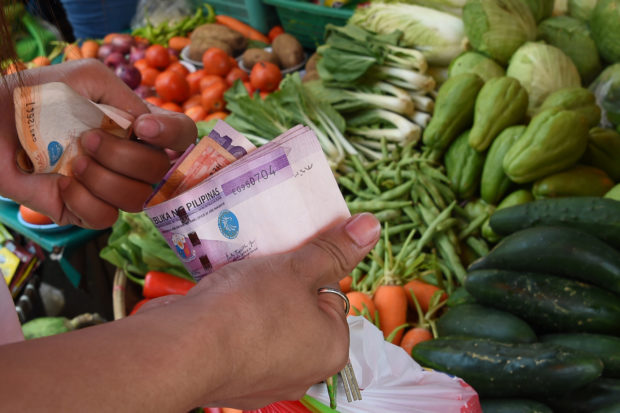PH inflation slowed to 4.8% in Sept

The country’s inflation unexpectedly slowed to 4.8 percent year-on-year in September, due mainly to steady transport costs, giving the Bangko Sentral ng Pilipinas (BSP) more room to maintain its interest rates at their current historic lows.
The latest Philippine Statistics Authority (PSA) data on Tuesday showed that the end-September headline inflation averaged 4.5 percent, still above the government’s 2 to 4 percent target range but below consensus estimates.
A recent Inquirer poll of economists yielded an expectation of a 5 to 5.2 percent inflation for September.
National Statistician Dennis Mapa said in a press briefing that the slight decline in the September inflation rate from the 32-month high of 4.9 percent in August came on the back of the decline in transport inflation to 5.2 percent from 7.2 percent in the previous month.
In particular, tricycle fare was leveling off compared to last year at the start of the COVID-19 lockdowns, which restricted movement of people, Mapa said, pointing to the same rates that Metro Manila trike riders paid in September 2020 and this year.
Mapa also cited some provinces where both tricycle and jeepney fares already declined from last year.
ING Bank Manila senior economist Nicholas Mapa said the 4.8-percent September inflation rate—lower than the previous month’s 4.9 percent, and at the low end of the central bank’s 4.8 to 5.6 percent prediction—has given authorities a reprieve from calls for tighten monetary policy.
Breathing room
“Pressure has been building on the BSP to hike prematurely but the surprise inflation print helps the central bank justify its current stance,” he said in an email to reporters. “[The] BSP has indicated its preference to give the economy a little more breathing room to aid in the recovery until clear signs of a recovery are evident.”
The BSP said the average rate of increase in the prices of basic goods and services was expected to settle “close to the midpoint of the target range in 2022 and 2023 with inflation expectations remaining firmly anchored to the target.”
The BSP said recent inflation upticks were expected to be driven largely by supply-side factors related to weather disruptions, global oil prospects, and continued impact of the African Swine Fever.
In a statement, the state planning agency National Economic and Development Authority (Neda) noted that food inflation eased to 6.5 percent last month from August’s 6.9 percent as fish and meat price hikes slowed.
In the case of pork, which drove headline inflation higher since late last year due to the African swine fever crisis, its 36.4-percent year-on-year price increase in September was below the 39 percent in August, reflecting a 1.6-percent month-on-month decline, Neda added.
Price burdens
Nationwide core inflation—which excluded volatile items such as food and energy —was “stable” at 3.3 percent in September and stayed within the 3-percent level in recent months, Mapa said.
But the easing of price burdens was more felt in Metro Manila where inflation declined to 3.5 percent in September from August’s 3.7 percent.
In contrast, inflation was faster outside Metro Manila, at 5.2 percent both in September and August. Thus the government wants to spread imported supplies, especially of pork, nationwide to address faster food price hikes outside Metro Manila.
Mapa said prices of food items like corn—a staple in the provinces—were on a “substantial” rise in areas outside Metro Manila.
In a text message, Socioeconomic Planning Secretary and Neda chief Karl Kendrick Chua said imported pork—which were brought into the country to augment domestic demand and address high prices—needed to be distributed across the country.
“Most pork supply is in NCR (National Capital Region), so we propose moving to outside NCR and sell in wet markets. Most imported pork is also sold in supermarkets,” Chua noted.
Inflation for the bottom 30-percent income households also eased to 5 percent last month from 5.3 percent in August and averaged 4.9 percent during the first nine months, higher than the headline rate, which meant the poor shelled out more money to buy basic goods.
In a statement, the BSP said the current inflation regime is, for the most part, out of its hands and can only be remedied by policies that would ease supply problems.
“These supply-side shocks are best addressed by timely non-monetary policy interventions that could ease domestic supply constraints,” the agency said in a statement. “The return of inflation to the target range is highly contingent on the successful implementation of these supply measures.”
The central bank has committed to keep interest rates low for now, despite the high inflation rate, stressing that the Philippine economy needs more help to recover from its deepest postwar slump caused by the coronavirus pandemic.
“The risks to the inflation outlook remain tilted towards the upside for the remaining months of 2021, but remain broadly balanced for 2022 and 2023,” the BSP said.
“Upside risks may come from pressures on world commodity prices, effects of weather disturbances, and prolonged recovery from the ASF outbreak,” it added. “On the other hand, downside risks are seen from the spread of more contagious COVID-19 variants and weaker-than-expected global growth prospects.”
